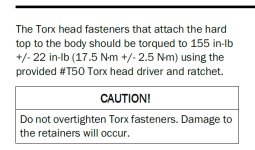Lunentucker
Hooked
We've all been there - searching the web for torque specs when wrenching on our JT and finding things here and there, not knowing what's accurate and what isn't.
That's what drove me to grab one of the last USB manuals for sale and to spend a few hours extracting every torque table I could find on it.
It only makes sense to share it here with fellow Gladiator owners.
These are from the 2020 Manual, but I am also updating any specs that have been changed by TSB's from Jeep.
* There are NO diesel-specific specs in this library. The manual I purchased does not include them. Everything else, not unique to the diesel build should be the same.
Here's the link.
2020 Gladiator Torque Specs
If you use the "Download All" link in the upper right corner of the main index you will be able to save everything including the folder structure.
If you notice something's missing or need anything from the manual in general just shoot me a PM and I'll try to help you out.

That's what drove me to grab one of the last USB manuals for sale and to spend a few hours extracting every torque table I could find on it.
It only makes sense to share it here with fellow Gladiator owners.
These are from the 2020 Manual, but I am also updating any specs that have been changed by TSB's from Jeep.
* There are NO diesel-specific specs in this library. The manual I purchased does not include them. Everything else, not unique to the diesel build should be the same.
Here's the link.
2020 Gladiator Torque Specs
If you use the "Download All" link in the upper right corner of the main index you will be able to save everything including the folder structure.
If you notice something's missing or need anything from the manual in general just shoot me a PM and I'll try to help you out.

Last edited:

